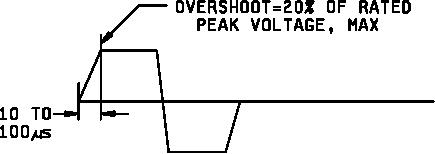
MIL-C-39022/9D
Insulation resistance (IR): Method 302 of MIL-STD-202. Charge time 5 minutes, maximum; however, for
capacitance values greater than 1.0 µF, an additional 1 minute per µF is permitted.
Terminal to terminal (dc rated voltage): See table II.
Terminals to case: 10,000 megohms, minimum.
Capacitance: Method 305 of MIL-STD-202.
Test frequency: 1 kHz ±100 Hz.
Limit of accuracy: Within ± 0.05 percent.
Dissipation factor (DF): See table II.
Test frequency: 1 kHz ± 100 Hz (capacitance values ≤ 1.0 µF) or 100 ± 10 Hz (capacitance values > 1.0 µF).
Limit of accuracy: Within ± 0.05 percent or within 10 percent of table II value.
Barometric pressure (reduced): Method 105 of MIL-STD-202, condition D (100,000 feet).
125 percent of dc rated voltage applied. See MIL-PRF-39022 for voltage limitations.
Vibration, high frequency: Method 204 of MIL-STD-202, condition D (20 G).
50 percent of dc rated voltage applied.
Salt spray (corrosion): Method 101 of MIL-STD-202, condition B (48 hours).
Salt solution: 5 percent.
Immersion: Method 104 of MIL-STD-202, condition C.
DWV:
Insulating sleeves: Greater than 4,000 V dc.
Terminal to terminal: 200 percent of dc rated voltage.
Terminals to case: 200 percent of dc rated voltage.
12